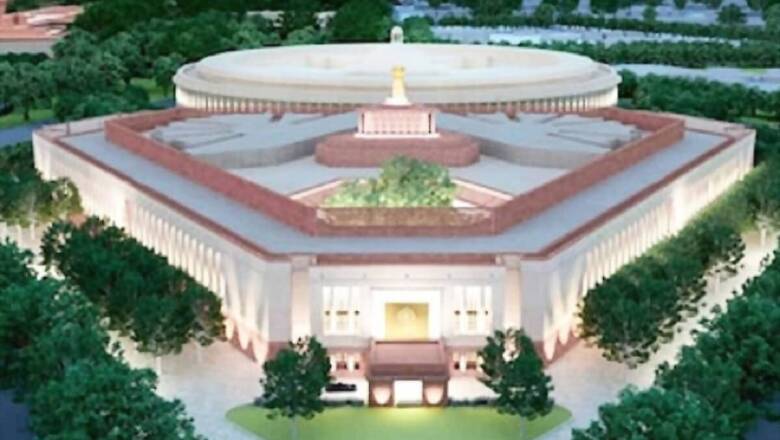
views
No group of ‘concerned’ retired top bureaucrats (CRTBs) attributed the idea of a new parliament building first mooted by former Lok Sabha speaker Meira Kumar (herself a former civil servant) in 2012 to tantriks, superstition or even to an egomaniacal desire of her supreme leader. It is clear that CRTB letter writers do not ascribe such irrational behaviour to one of their own. Nor do they think that their own actions can ever be characterised as such.
So Urban Development Minister Hardeep Singh Puri’s stinging broadside this week must have come as a nasty surprise. After all, he is also one of them—a retired civil servant—but, unlike them, he has not been put out to graze. And write letters, of course. The CRTBs also do not realise that ascribing superstition as a motive to this follow-through of Kumar’s idea also sheds a less than kindly light on their own actions and those currently still in service.
At the time Kumar took the first steps towards a new building—that included a letter from her OSD to the Union urban development ministry citing the bad condition of the Herbert Baker-designed Parliament House—no CRTBs voiced their angst. Maybe because many letter writers were still in service at the time. And, of course, there was no social media platforms for earlier CRTBs to air their concerns well before the postman could do his job.
Contrary to “reports” that have now reached the CRTBs ears, no one actually has to resort to the extra-sensory perceptions of tantriks to realise the current Parliament building’s situation is parlous. Those who as serving bureaucrats sat in the galleries flanking the MPs seats in the Lok Sabha and Rajya Sabha rarely looked skywards for inspiration or succor. Otherwise, they could not have missed the patches of damp and cracks on the domed ceilings.
The efforts to bring a heritage building up to speed in the age of air conditioning and information has been decidedly unsympathetic to its delicate architecture. A peek into the less-exalted environs of the building show cruel holes in walls and ceilings to allow ingress of cables, pipes and ducts. As maintenance is predictably bad, the detritus of various repairing sprees remain on site as a breeding ground for not only damp but also dust, grime and vermin.
A metallic net has been affixed to the ceilings of the Lok Sabha and Rajya Sabha, probably to protect the fragile plasterwork and prevent any recalcitrant chunks from taking a kamikaze dive and landing on lawmakers’ heads. There is also plenty of other evidence of ad hoc patch-up jobs. As stop-gap measures, these are fine; but how long could it go on without proper large-scale repairs that would need both chambers to be vacated for long spells of time?
In 2018, British MPs voted to move out of their historic Houses of Parliament in Westminster to allow major renovation work—that will cost many times more than making a new one, of course! It was felt that the repairs on the mid-19th century building should have begun at least 40 years earlier. A parliamentary committee listed fire, sewage inundation and electrical failure as imminent risks. One MP even said urine was leaking into his office.
Some stonework had not been cleaned since work began on the current Westminster building in the 1840s and sections are crumbling; parts of the roof also need repair. There is also justifiable concern about asbestos—commonly used before it was found to be carcinogenic—still lurking behind false ceilings and walls in the innards of the building. All these factors are equally applicable to the Parliament building at the foot of Raisina Hill.
It is estimated that the repair work on Westminster—a Unesco World Heritage site—will cost £10 billion and begin in the mid-2020s with MPs relocated elsewhere for sessions for at least five to six years, which is an additional cost to be computed. The new Indian parliament building with all the latest mod-cons (and enough place for 400 more MPs after delimitation in 2026) will cost, as per stated current estimates, a shade under £85 million.
For the bunch of CRTBs and other people very agitated about costs of buildings and repairs these days—vis-à-vis other spending imperatives—the benefits should be evident without the inputs of tantriks, clairvoyants or political leaders. And the issues highlighted about Westminster by those who occupy it (the MPs) are not only relevant to our own 1920s Parliament House but even government buildings that came up in later decades along Rajpath.
Most CRTBs have worked in sarkari buildings now earmarked for demolition at Rajpath at some point in their careers. They must be among the very few who were totally happy with their workspaces for them to be so concerned now that these buildings will make way for more ergonomically designed ones. Perhaps it is because being from the very highest echelons of the bureaucracy, they never really saw where and how the hoi polloi below worked.
The state of most of the offices—barring those for ministers, their immediate staff and the senior-most bureaucrats—is cringeworthy. That joint secretaries and above have personal keys to access toilets out of bounds for their junior colleagues is a pungent reminder of the dire situation. Crumbling ceilings, windows obscured by coolers and ACs, almirahs of dusty files, paan-spittle stained corridors and stairs are the domain of the not-so-lofty.
If a straw poll is ever done among lower-level government employees past and present—doomed to sit out their careers in ill-lit, badly ventilated, crowded and smelly environs—about the prospect of brand new offices with more space, light and amenities, their reaction would be markedly different from CRTBs. They would definitely say tantriks are not needed to convince them that better offices make for better productivity – and better health.
The cost of retrofitting the existing inadequate, dilapidated government office buildings to 21st century standards in terms of ventilation, workspace, energy conservation and communication would be astronomical. As much as the cost of new buildings. Indeed, in case of Westminster, it is estimated that repairing it with the MPs and staff in situ—or only moved out in batches—would cost up to four times as much and take up to 32 years.
Not many people know that the Capitol Building in Washington DC that houses the US Senate and House of Representatives in two wings connected by a central colonnaded rotunda topped by a huge dome has been expanded in phases ever since it was first constructed in 1800. As the states and lawmakers increased, the building added wings (and two domes in succession), with the older chambers being made into museums. That sounds familiar…
That Puri called out fellow former bureaucrats marks a watershed in this one-way discourse. No one writes an open letter back to CRTBs after all. And while they constitute a minority of the vast number of retired IAS, IFS, IPS and other ‘class 1’ officers, by default some 60, 120 (or whatever number is contacted to affix their signatures to particular letters) claim to speak for them all. Is there any reason for anyone to take them seriously?
Their concern about the Central Vista project is puzzling. Do they secretly crave to work in those decrepit buildings along Rajpath again? Do their children or their wider family or social circle want to do so? The government should temporarily billet them in the very offices CRTBs never entered as serving officers—the cubby holes that pass for offices of the lower bureaucracy. That may have a salutary effect on their perspective on this issue.
It may be germane to also find out how many of them frequent Rajpath’s lawns along with the hundreds of middle-class families who regularly flock to its open spaces and lines of ice cream vendors. Anecdotal evidence suggests that CRTBs are more likely to be found sipping sundowners on Delhi Gymkhana Club’s exclusive lawns as most of their careers have not exactly been spent directly engaging with the ordinary folks found on those lawns.
The CRTBs has voiced many other concerns about the project in their ‘open letter’ which are based on ‘reports’ and ‘facts’ that are about as reliable as their information that the new Parliament House was initiated due to ‘superstitions’ that it was unlucky rather than an understanding of the travails of an ailing heritage building. Each of those points deserves to be called out, with at least as much vigour as the minister’s denouement. Watch this space!
Read all the Latest News, Breaking News and Coronavirus News here.

















Comments
0 comment